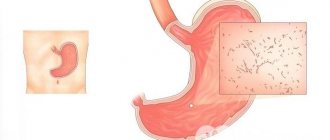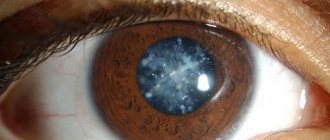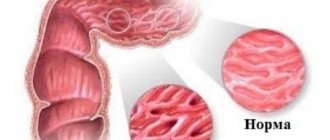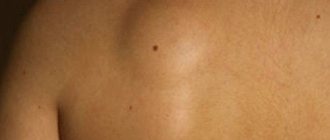Our eyes are a complex optical system consisting of many elements, the coordinated work of which determines a person’s perception of the surrounding world. Any dysfunction of the organ of vision is a serious problem that affects a person’s well-being, performance, and social adaptation.
One of the manifestations of such dysfunctions is nystagmus - involuntary movements (oscillations) of the eyeballs of different frequencies and directions. The most common form of this pathology is horizontal nystagmus, vertical and other types are slightly less common.
What does this disease mean, how effective is its treatment? Let’s try to figure it out.
general characteristics
Nystagmus, what is it? The disease nystagmus is characterized by involuntary oscillations of the eyes, which have a pendulum character. The causes of the disease are physiological and pathological changes.
Physiological nystagmus is oscillatory eye movements when a person moves in space. In this case, this is considered an element of the norm and is responsible for maintaining normal vision.
The development of nystagmus is preceded by several factors.
A common cause of the development of the disease is the manifestation of the disease from birth, or its acquisition throughout life, which can be associated with various diseases (loss of transparency of the optical spheres of the eye, albinism, degenerative changes in the retina, and so on).
These diseases provoke disturbances in the mechanism of visual fixation, which provokes nystagmus.
What it is?
Nystagmus is a type of eye pathology, which, when trying to fixate the gaze on an object, is characterized by frequent movements of the eyeballs in different directions. These are frequent, involuntary vibrations of the eyes, repeated horizontally, vertically or in a circle.
Externally, nystagmus may appear:
- movements of the eyeballs from side to side (pendulum-like);
- rapid oscillations in one direction, with a slow return to the normal position (jerky).
If normally eye movements are synchronous and controlled, then nystagmus is their chaotic, unconscious movement, in which patients see only blurry outlines of surrounding objects and therefore sometimes cannot give them an accurate definition, which is why their orientation in space and processes of perception of the surrounding world.
This deviation is detected during
a simple visual test , that is, when the patient monitors the smooth movement of the finger of a medical specialist (ophthalmologist, neurologist, traumatologist, etc.).
Spontaneous nystagmus is often detected; it usually intensifies when the eyes move left and right or to one side. Pathology often occurs with lesions of the ear labyrinth or diseases of the central nervous system. Signs of nystagmus include:
- from the ophthalmic ones, i.e. characteristic vibrations of the eyeballs;
- from bodily, i.e. unnatural position of the head (ocular torticollis), the patient gives a position to the head in which the manifestations of nystagmus decrease or disappear;
- from the symptoms accompanying the underlying disease (decreased visual acuity, neurological disorders, metabolic disorders, etc.).
Classification of nystagmus
Source: treatment-online.com.ua
There are quite a lot of classifications of nystagmus, the main of which are the division of this disease by type, scope, direction and origin.
Types of nystagmus:
- Jerky nystagmus, in which the slow phase goes in one direction and the fast phase in the other.
- Pendulum-like nystagmus develops in oscillatory phases of equal magnitude.
- A mixed variant, in which looking forward resembles a pendulum-like nystagmus, and when looking to the sides, it resembles a jerky nystagmus.
By span (measured in degrees):
- Large-scale - fluctuations are about 15 degrees.
- Medium spread - about 10 degrees.
- Small-swinging - vibrations equal to 5 degrees.
By stages (severity):
Stage 1 - symptoms of nystagmus do not appear at rest, but are detected only when the eyeball is completely abducted to the side.
Stage 2 - visible nystagmus with the central position of the eyeball.
Stage 3 - detection of nystagmus in the medial abduction of the eyes.
It should be noted that the frequency with which such movements of the eyeball occur can reach 100 or more per minute.
In the direction of nystagmus there is:
- Horizontal nystagmus - in turn, can be left- or right-sided - eye movements go to the right or left side.
- Vertical nystagmus - there is upper and lower.
- Rotatory nystagmus - the direction of movement is circular.
- Diagonal - in this case, the direction of a particular type of movement is assessed by which phase is faster.
According to the mechanism of occurrence, nystagmus is divided into:
- Acquired (usually occurs in adults) - with this form there is always blurred visual sensations, although central vision does not change and can remain quite high. In addition, with congenital nystagmus, dizziness is always observed.
- Congenital (in children) - unlike acquired dizziness, dizziness is not observed.
It should be noted that the classification includes such forms in which nystagmus can be physiological, namely:
- Optokinetic nystagmus occurs when a person tries to look at objects moving quickly in front of the eyes. The direction goes in the direction opposite to the movement.
- Twitching physiological nystagmus - occurs when the eye muscles are overworked with maximum eye abduction to the side.
- Labyrinthine - appears when the labyrinth is irritated (heat or cold).
Prevention
You can avoid the development of nystagmus in adulthood if you follow the following preventive measures:
- do not use drugs;
- give up alcoholic beverages;
- take medications carefully, first familiarizing yourself with possible side effects;
- normalize work and rest schedules;
- avoid emotional tension and stress;
- Healthy food;
- avoid head injuries;
- adhere to visual hygiene;
- promptly identify and eliminate health problems.
It is often not possible to prevent the occurrence of oculomotor disorders in children. But the likelihood of developing pathology can be reduced if you lead a healthy lifestyle during pregnancy and are regularly examined by a doctor, following all his instructions.
You can reduce the risk of uncontrolled movements of the eyeball if, as a child, you regularly swing on swings, go on rides and watch fast-moving objects.
Types of disease
Source: clinicaoftalmologicacimo.es
Congenital
Congenital nystagmus is traditionally caused by a number of pathologies and conditions, because after the birth of a baby, abnormalities in visual motor skills begin to manifest themselves almost immediately, and they persist throughout life. Usually this disease is horizontal and jerky.
The acquired disease manifests itself in the course of a violation of visual motor skills in the central or peripheral nervous system, and the disease can manifest itself at absolutely any age.
Types of congenital diseases:
- optical small-scale nystagmus occurs during visual impairment and manifests itself in the early months of life;
- the latent form of the disease often manifests itself in children suffering from strabismus (strabismus), only when the eyelid closes one eye; it has a jerky character;
- clonic syndrome involves a slow deviation of the eye in a certain direction, after which it returns to the opposite position; the disease traditionally occurs within the slow phase;
- spasm with nodding is a rare form of manifestation of the underlying disease and occurs at the age threshold of 4-14 months, accompanied by the phenomenon of head nodding.
Acquired
Types of acquired disease:
- central nystagmus is provoked by diseases of the central nervous system, such as tumors, strokes in the brain stem or cerebellum; its symptoms are numerous and may include dizziness;
- peripheral disease - its causative factor is a lesion of the vestibular analyzer of an infectious nature in the labyrinth, trauma or syndromes; in this case, horizontal transient movements of the eyeballs are observed, loss of balance and complete loss of hearing may occur.
Some varieties of this pathological disease can only be determined with the help of specialists. Some of them indicate directly the location of the lesion, others indicate that there is a certain disease in the body.
According to the nature and causative factors of its occurrence, the disease can be physiological or pathological in nature.
Physiological
It is observed in people who do not suffer from diseases and occurs under the influence of a certain set of stimuli.
Traditionally, it manifests itself in several forms and features:
- the establishing disease is small in frequency, small and jerky, if its fast phase occurs, it is directed according to the gaze, it is formed when a person averts his gaze extremely;
- vestibular nystagmus is observed during a caloric test, is of a jerky type and is characterized by a certain set of signs;
- optokinetic disease - being in the slow phase, the eyes begin to move behind the object, but if it is fast, the disease is spasmodic in nature.
Studies of this group of diseases are useful in diagnosing a large number of diseases, for example, optokinetic disease can be used to identify visual indicators in children or to identify malingerers.
Pathological
This disease manifests itself in the course of lesions of various origins, most often manifests itself in several forms and is characterized by an extensive classification characteristic:
- ocular nystagmus develops during the early acquisition of visual weakness, also a pathological process of this type can be congenital in nature, fluctuations in this disease are caused by the fact that there is a serious disorder in the function of visual fixation or the mechanism that ensures its regulation, movements have different amplitudes and character;
- professional nystagmus occurs among mine workers with many years of working experience, it is caused by constant tension in the visual system and chronic intoxication, insufficient lighting, eye movements are mixed and are accompanied by photophobia, progression is observed through an increase in working experience, which entails a noticeable deterioration vision functions;
- labyrinthine nystagmus - the development of this pathology occurs against the background of a noticeable lesion in the area of the inner ear, it is rotatory in nature, and the fast phase is aimed towards the labyrinth affected by the lesion, in most cases the disease is widespread;
- central vestibular nystagmus can be caused by traumatic phenomena of the central nervous system, inflammatory processes or pathologies of a degenerative nature, the severity depends on the nature of the lesion, the disease is jerky;
- spontaneous nystagmus can be of a fixation nature (setting nystagmus), or be a nystagmus of exhaustion, in the first case we are talking about people suffering from neurosis, in the second spontaneous nystagmus (setting) suggests various diseases of the brain and eyes.
Most often, spontaneous nystagmus is diagnosed due to the prevalence of the causative factors of its occurrence.
Alcoholic
This is a painful condition manifested by uncontrollable jerky movements of the eyeballs that occur when looking up and to the sides. Subjectively, it is felt as an illusion of rotation, called “helicopters” in everyday life.
“Helicopters” after a single consumption of alcoholic beverages, as a rule, do not last long and disappear within 2-5 hours. It is easier to tolerate this condition lying face down, in conditions of rest.
There is no specific method of combating the “helicopter”, but the rapid removal of ethanol from the body and the fight against intoxication will help reduce the symptom. You need to drink more liquid, you can use sorbents like regular activated carbon, apply a cold compress to your forehead.
Important
The causes of nystagmus are dysfunction of the oculomotor system, which causes involuntary movement of the eyeballs
In case of alcohol intoxication, the cause of the disorder is damage to the areas of the vestibular system and the cerebellum.
Therefore, nystagmus that persists for a long time after an episode of alcohol abuse is an alarming signal of damage to the central nervous system.
This observation suggests that after alcohol is removed from the blood plasma and tissues, the consequences of intoxication remain, which means that we can talk about organic damage. Undoubtedly, it is necessary to treat such patients in a specialized hospital.
Acquired nystagmus
The very name of this type of disease implies that the cause is diseases, one of the symptoms of which is nystagmus. In some cases, it may be the only one to suspect a more serious illness.
Depending on the location of the lesion in the main part of the brain, peripheral and central nystagmus are distinguished. Central occurs with lesions in the central parts of the brain . These may be organic lesions of the central nervous system, such as multiple sclerosis, cerebral palsy, cerebellar tumors, and circulatory disorders.
A feature of central nystagmus is that a person may have other manifestations of the underlying disease. Since this type of deviation in the functioning of the muscular system of the eye is detected along with other symptoms of brain damage, a neurologist should observe and treat the patient. In clinical practice this often happens. The ophthalmologist acts only as an additional consultant in establishing the correct diagnosis.
Another type of acquired nystagmus is peripheral. It is also associated with changes in the central nervous system, but in the peripheral part of the vestibular region , which is why it is known as vestibular nystagmus. The causes of changes in the vestibular system can be infections, injuries .
A characteristic feature of this nystagmus is that the abnormal movements last for several days and then go away on their own. Peripheral nystagmus is always accompanied by dizziness, and can also be combined with hearing loss and balance problems.
The division of nystagmus into peripheral and central is of diagnostic value for the doctor. It can indicate the location of damage in the central nervous system, thus pointing to the correct diagnostic path.
If a previously healthy person develops nystagmus, trembling of the eyeballs and blurred vision, the patient should be examined by an ophthalmologist, neurologist and otolaryngologist. In an adult, the appearance of nystagmus may indicate quite serious diseases of the central nervous system.
Peripheral and central nystagmus are types of pathological nystagmus. Pathological nystagmus also includes ocular and occupational . The ocular appearance manifests itself against the background of acquired visual impairment, although it may be congenital. Oscillatory uncontrolled movements of the eyeballs are caused by a disorder of the visual fixation function. Visual acuity in most cases decreases.
The examination usually reveals albinism, retinal dystrophy, congenital cataracts, and macular coloboma. Occupational nystagmus, accordingly, can accompany the influence of occupational factors, or rather their excessive influence.
For example, long stay of miners and inhalation of methane vapor leads to a mild degree of intoxication and the appearance of short-term fluctuations in the eyeballs. Over time, this symptom may increase in both the frequency of manifestations and the amplitude of oscillatory movements. Therefore, it is important for employees to comply with safety measures and undergo regular medical examinations.
Causes
The main cause of the disease is unstable functioning of the oculomotor system. Such instability can develop under the influence of central or local factors.
Local factors: acquired or congenital vision loss due to eye diseases, such as optic nerve atrophy, optical clouding, albinism, strabismus, astigmatism, farsightedness, myopia, retinal dystrophy and others.
Central factors: lesions of the pons, cerebellum, labyrinth, pituitary gland, medulla oblongata, systemic vertigo (Meniere's disease), poisoning with drugs or narcotic substances, trauma, ear infections.
Important
Spontaneous nystagmus is a symptom of a pathological process in the brain in the labyrinth of the inner ear.
Horizontal nystagmus occurs when the middle parts of the rhomboid fossa are affected, diagonal or vertical is a sign of damage to the upper parts of the rhomboid fossa, and rotational is a sign of damage to the lower parts.
The amplitude of eyeball movement is an indicator of the level of damage to the vestibular analyzer. Ocular nystagmus can also appear due to severe tension in the central nervous system due to temporary disorientation (for example, after riding extreme rides).
In such cases, the work of the oculomotor system is normalized after orientation is restored and the nystagmus disappears.
Congenital nystagmus
A very important stage in the first days of a child’s life is the long-established patronage of the newborn. In the first weeks of life, light perception begins to actively develop. The development of retinal elements will depend on how the baby perceives light stimuli. Therefore, it is important to provide the child’s room with sufficient lighting. This does not mean that you need to add a huge amount of light, but you should not artificially darken the room during the daytime.
The movements of the eyeballs in the 1st - 3rd week of a child’s life are chaotic in themselves. This is conventionally considered to be physiological nystagmus of the newborn. When receiving the first visual information, the muscular apparatus of the eye is adjusted to work in the desired direction, which is set by the central apparatus of the visual analyzer.
If there is no pathology in the visual system and central apparatus, then by 1.5–2 months the child will clearly, almost consciously, fix his gaze on objects already familiar to him. If there is a pathology, then parents will notice involuntary oscillatory eye movements at 1 - 2 months, as a sign of a lack of fixation ability.
Therefore, an examination by an ophthalmologist at the age of 1 month should not be postponed or neglected. Moreover, an unprofessional eye may not notice the initial manifestation of nystagmus.
Congenital nystagmus is divided into three types.
- Optic. It is based on the presence of diseases of the organ of vision. This may be hereditary retinal abiotrophy, abnormal development of the eyeball, or high myopia. This form is more common in premature babies and may be a consequence of birth trauma.
- Latent. Usually occurs with amblyopia or strabismus. It is characterized by the fact that involuntary eye movements begin when the healthy eye closes.
- Nodding spasm. This form of nystagmus is detected in the 4th month of life. Associated with torticollis and head nodding. However, nodding movements always lag behind the movements of the eyeballs in speed.
Symptoms
Source: zdorovi.net
Eye nystagmus develops when there is a certain eye disease, its symptoms are similar to those of the underlying disease.
The patient experiences sensitivity to light, frequent dizziness, and poor vision. Often patients complain of a blurry image before their eyes, or its fluctuation and trembling.
During examination, the ophthalmologist notes a significant fluctuation of the eyeball, which can have a variety of directions. Eye movement can occur either spontaneously or due to certain provoking factors.
Depending on the direction there are:
- Horizontal view;
- Vertical.
The right eye moves to the right side faster than to the left, this phenomenon is jerky. Sometimes there is a mixed type, in which when a person looks straight ahead there is a pendulum movement, and in one direction there is a jerky movement.
Symptoms in children are divided into several types.
After the first month of life, the child’s gaze must focus. If this does not happen, then suspicion falls on the existence of nystagmus in the eye. Sometimes, this phenomenon is congenital in nature, and is formed during intrauterine development.
This deviation has the following features:
- Formed in the second month and occurs throughout life;
- Pathology is absent when the eyes are closed;
- The nature of the direction is horizontal and jerky.
In some directions the symptom does not manifest itself in any way.
Spasm of a sternocleidomatous nature. It appears between the ages of three months and one year. If the cause cannot be determined, then sometimes it completely goes away by the age of three.
Sometimes the reason lies in the development of a pathological tumor. Low-amplitude nystagmus is sometimes accompanied by head nodding.
Latent nystagmus. Occurs in the presence of strabismus not accompanied by various types of paresis. A characteristic of this condition is that nystagmus does not appear when the eyes are open, and occurs only when the lighting deteriorates.
This disease can occur in people with albinism, a condition where there is no pigment in the iris.
Can nystagmus be cured?
Treatment for eye fluctuation is very complex and lengthy, directly depending on the underlying cause. It is not possible to achieve an ideal result; we are talking about a significant improvement in the quality of vision and maximum elimination of cosmetic defects.
Depending on the cause of nystagmus, treatment is varied. First, you need to correct your visual acuity with glasses or lenses, preferably contact optics.
Treatment of nystagmus in children is practically no different from adults, the main thing is timely diagnosis. Medications are used: eye drops and ointments, physiotherapeutic procedures, pleoptic treatment; vibrating massage devices and computer games for the treatment of nystagmus are popular for children.
Multifaceted therapy necessarily includes surgical intervention, the purpose of which is to block eye nystagmus with the central position of the eyeballs. This is a complex, specific operation in which you need to calculate the ideal angle of change in position. Nowadays, computer programs are used for this, which, after a thorough examination and entering parameters, produce accurate results down to degrees.
Diagnostics
Source: budlaska.ru
Almost any doctor, after examining a patient, can diagnose eye nystagmus, due to the presence of chaotic movements of the eyeball. To find out the cause, you will need a comprehensive diagnosis.
The doctor will examine visual acuity, the appearance of the retina and fundus of the eye, and will also check the correct functioning of the oculomotor system. Next, the patient will be referred for a consultation with a neurologist to undergo procedures: EEG, Echo-EG.
After successful diagnostic tests and results, the doctor prescribes therapeutic treatment. The first thing that needs to be done is to eliminate the underlying disease that triggered the development of nystagmus.
Vasodilating eye drops are indicated for use, as well as vitamins that are necessary to nourish the eye and retina.
A simple visit to an ophthalmologist is enough to establish a diagnosis. An experienced specialist already during a visual examination notes the presence of this disease. To determine the type of nystagmus, it is enough for him to ask the patient to focus his gaze on a pointer, which he will move in space.
If the diagnosis is confirmed, the ophthalmologist may prescribe an additional examination: MRI (magnetic resonance imaging). This test checks the brain for tumors that may cause nystagmus.
Microperimetry is the combined use of computer perimetry and examination of the retina. Used to determine disease parameters.
Important
Echoencephalogram. This is an ultrasound diagnostic method that allows you to obtain accurate information about the condition of brain tissue.
Electroretinogram (ERG) is a method for studying the functional state of the retina.
Electronystagmography (ENG) is a method of recording biopotentials that arise during reflex twitching of the eyes. Additional consultation with a neurologist or neurosurgeon. Blood test for toxins.
Sometimes surgical intervention is indicated in which weakened muscles are strengthened, or very strong ones are weakened. This procedure allows you to reduce the amplitude of oscillatory movements of the eyeballs. A cure is possible, but it is a long and difficult process.
Diagnostic methods
Diagnosis should be carried out in a timely manner and in full with the involvement of doctors of other specialties.
The patient's complaints are caused by visible oscillatory movements of the eyeballs. A patient with nystagmus exhibits trembling of objects, blurred objects, and decreased vision. With the naked eye, a doctor of any specialty will notice nystagmus. Diagnostic measures when such a patient contacts an ophthalmologist begin with conventional techniques. Since with nystagmus there is always a deviation in visual acuity, visometry .
A mandatory point is to determine the correction. Skiascopy in this case is a low-informative technique, but refractometry must be performed. Despite the fact that the oscillatory movements of the eyeballs do not allow a full examination, aftorefractometry can be performed at a certain position of the head, when movements occur at the slowest pace.
Biomicroscopy is important for determining the transparency of optical media. The presence of opacities in the lens will indicate an ocular form of nystagmus. An important part of an ophthalmological examination is ophthalmoscopy . Examination of the fundus reveals retinal pathology in the ocular form of nystagmus, and an unhealthy color of the optic disc will indicate some disease in the central nervous system.
If signs of brain damage are detected, a neurologist, and in some cases a neurosurgeon or neuro-ophthalmologist, should be involved in the examination. It is necessary to supplement the examination with studies such as electrophysiological examination of the retina and optic nerve (EPI), optical coherence tomography of the fundus of the eye (OCT), computer perimetry .
Despite the fact that nystagmus is largely a neurological symptom, ophthalmological examination and diagnosis are not the least important. In order to correctly prescribe further examination and correct treatment, it is necessary to exclude or, conversely, confirm pathology of the organ of vision.
is used to identify the cause of central nystagmus . The method is quite informative in terms of identifying organic brain diseases. An ophthalmologist can also prescribe an examination, and if a problem is detected, refer it to a specialist.
Thus, nystagmus is a reason to consult doctors of two specialties at once. It doesn’t matter who you have to come to first for help. In this case, the positive effect of the treatment will depend on the coordinated action of both doctors.
Treatment
Treatment of the disease and prevention Before prescribing a course of treatment, the doctor must determine the cause of nystagmus.
In most cases, therapy is quite long and complex, it includes taking medications, optical vision correction and surgical methods. Drug therapy is more of an auxiliary method than the main one.
As a rule, the following groups of drugs are prescribed:
- Vasodilators;
- Drugs aimed at improving metabolism;
- It is possible to prescribe neurometabolic stimulants;
- Vitamin complexes.
Optical vision correction includes the selection of individual lenses or glasses using special equipment. People with albinism are offered glasses with yellow, orange and neutral color filters.
Surgical intervention is aimed at correcting the muscle tissue of the eye, in order to form the main resting position of the eyes. If you consult a doctor in a timely manner and follow all prescribed measures, there is a high probability that surgical intervention will not be needed and the prognosis will be very favorable.
Of course, if the cause of nystagmus is serious pathological diseases, then all therapy is aimed primarily at treating the disease.
Treatment methods for nystagmus
There is no treatment for physiological nystagmus; oscillatory eye movements disappear immediately after the provoking factor is eliminated. An oculomotor disorder of a pathological nature cannot be completely cured; therapy is selected aimed at reducing the frequency of eye movements. The treatment regimen for adults is based on the elimination of the underlying disease that caused the disturbance in the oscillations of the eyeballs. If there is a brain tumor, it must be removed surgically.
To eliminate nystagmus caused by intoxication, it is enough to stop taking the drug or substance that is poisoning the body. If the problem arose against the background of central vestibulopathy, then neurotropics from the group of anticonvulsant and antiepileptic medications are prescribed. Conservative treatment of the disease may also include the following:
- anticonvulsants, vitamin eye drops, immunostimulants;
- drugs to improve brain nutrition from the group of nootropics;
- botulinum toxin injections – reduce strong eye movements;
- optical vision correction with glasses or contact lenses;
- Antibacterial therapy for the inflammatory process.
Medications may also be prescribed to reduce or eliminate symptomatic manifestations. In advanced cases, an operation is performed, the essence of which is to form a position of relative rest of the eyes by restoring the physiological position. This is accomplished by changing the structural characteristics of the extraocular muscles. The forced position of the head is eliminated and strabismus is eliminated.
Nystagmus in children
Source: indiamart.com
General information
Nystagmus in children is a disease that externally manifests itself in the fact that the child cannot fix his gaze, his eyes constantly make involuntary oscillatory movements, “running.”
Normally, at birth, a child’s visual acuity is still low, and the eyes do not fix objects and “wander.” But by the first month of life, the child can already follow the toy, he clearly fixes the object.
Nystagmus in children is a disease that is externally manifested by the fact that the child cannot fix his gaze, his eyes constantly make involuntary oscillatory movements.
Congenital nystagmus in children is quite rare. The cause of childhood nystagmus can be disorders in the central nervous system, both congenital and due to birth trauma. Another cause of nystagmus in children is albinism.
Albinism is a hereditary disease characterized by decreased or complete absence of pigmentation in the skin, hair, eyes (oculocutaneous albinism), or only the eyes (ocular albinism). Children with albinism have white skin; eyebrows, eyelashes and hair are completely devoid of pigment.
Due to a lack of pigment in the retina, the functions of its nerve cells are disrupted; in addition, children with albinism initially have disorders both in the central region of the retina and in the optic nerve. As a result, infantile nystagmus occurs.
Nystagmus in children in almost all cases is combined with both organic (irreversible) changes in the visual system (partial atrophy of the optic nerve, dystrophic changes in the fundus) and functional (reversible) disorders.
Important
Functional disorders in childhood nystagmus develop against the background of concomitant pathology, primarily farsightedness, astigmatism, myopia or strabismus. With these diseases, a blurred, unclear image is formed in the fundus.
Added to this is the constant movement of the eyeballs and image displacement. As a result, an unclear picture is transmitted to the higher parts of the central nervous system, so the visual cells of the cerebral cortex do not develop enough and visual acuity decreases.
Treatment methods
Treatment of nystagmus in children can only be started after a comprehensive examination. In addition to examination by a pediatric ophthalmologist, a consultation with a neurologist is required. If necessary, the neurologist prescribes additional studies (EEG, Echo-EG, MRI).
This is necessary to assess the functions of the central nervous system.
An examination by an ophthalmologist includes both a study of basic visual functions (visual acuity, the state of the optical media, fundus, optic nerve, examination of the oculomotor system) and more in-depth electrophysiological studies (EPS).
Using EPI, you can objectively assess the state of the visual-nervous system from the retina to the cerebral cortex. This is necessary to determine the level of damage in the conduction system and determine treatment tactics for nystagmus in children.
If there is a concomitant refractive pathology (farsightedness, myopia, astigmatism), the child is prescribed glasses. However, wearing glasses alone is not enough to treat childhood nystagmus.
Complex treatment of nystagmus in children is necessary, including methods of conservative and surgical treatment of childhood nystagmus. Conservative hardware treatment of nystagmus in children is aimed at improving visual acuity. It is conducted in courses of 2-3 weeks, several times a year.
Treatment of childhood nystagmus involves various methods of stimulation of the visual system. To carry it out, permission from a neurologist is required.
Important
In addition to conservative methods of treating nystagmus in children, there are surgical methods for treating childhood nystagmus.
Surgeries for the treatment of nystagmus in children are aimed at reducing the amplitude and frequency of oscillatory eye movements. Surgical treatment of childhood nystagmus is carried out as a stage in the complex treatment of this pathology.
A child with nystagmus should be under medical supervision until the processes of active growth and development continue, i.e. up to 14 - 15 years old. With timely treatment of nystagmus in children, in most cases it is possible to increase visual acuity and reduce its amplitude.
With nystagmus, due to constant oscillatory eye movements in children, vision decreases, and this has a serious impact on the formation of the entire visual system of the child.
Therefore, treatment should be started as early as possible to prevent further decline in visual acuity.
Since the child’s visual system is in constant development, all treatment methods used are more effective in younger children.
A little anatomy
To understand what nystagmus is and where it comes from, you need to know the basic functionality of the eye.
Nystagmus is an involuntary oscillatory movement of the eyeballs, uncontrolled by the central nervous system. The position of the eyeball and its movements depend on the functioning of the muscular system of the eye. There are eight muscles in the orbit, six of which move the eyeball: four rectus muscles - superior, inferior, internal and external, two obliques - superior and inferior . Of these muscles, the superior oblique is innervated by the trochlear nerve, the external rectus by the abducens nerve, and the rest by the oculomotor nerve.
The eye muscles form a muscular funnel in the orbit. Inside it there is the optic nerve, the ophthalmic artery, the oculomotor, nasociliary and abducens nerves. The friendly and directed work of all muscles ensures the eyes not only the correct position in the orbit, but also participates in the construction of correct gaze fixation, which is an important point in binocular vision.
The functions of the extraocular muscles are determined by their position and place of attachment. The external and internal rectus muscles are located strictly horizontally, symmetrically to the edge of the cornea, therefore, when they contract, they give the eye a lateral position inwards and outwards, respectively.
The lines of attachment of the superior and inferior rectus muscles are located obliquely relative to the edge of the cornea, so that the outer end is further from the edge of the cornea than the inner. Therefore, both muscles, in addition to turning the eye up or down, rotate it inward.
Hence, when the eye is directed straight forward, the eye cannot turn upward or downward until it is in a state of some abduction outward, under the influence of the external rectus muscle. The superior oblique muscle turns the eye downwards and outwards, that is, in the opposite direction from the inferior rectus muscle, which also turns the eye downwards.
Therefore, only the simultaneous action of these two muscles with the absence of rotation around the vertical axis will lead to straight downward movement of the eye. The inferior oblique muscle turns the eye upward, like the superior rectus, and outward, opposite to it. With the combined action of these muscles, the eye will rotate straight up around the horizontal axis.
Thus, the external muscles of the eye rotate it in all directions of the vertical and horizontal axis and, according to their physiological action, are divided into four groups: abductors - the external rectus and both obliques; adductors – internal, superior and inferior straight lines; levators - superior straight and inferior oblique; lowerers – lower straight and upper oblique.
The complex functional relationships of the eye muscles have great physiological significance in associated eye movements, an important component of binocular vision. The oculomotor, abducens and trochlear nerves are cranial nerves and ensure the functioning of the muscular system at the central level. During our waking hours, our eyes work all the time. To ensure clear vision in constructing an image, the motor muscles ensure correct fixation of objects.
Correctly formed binocular vision is important for good vision. Normally, binocular vision, or vision with both eyes, occurs due to the merging of visual images perceived by the macula of both eyes into one visual sensation. When a person with normal binocular vision looks at an object, both eyes make an adjustment movement that transfers the image to the central recesses of the yellow spots of both eyes. In this case, the image is perceived as one.
The existence and normal function of binocular vision, of course, is possible only with sufficient visual acuity in both eyes and the absence of significant aniseikonia, as well as with the ability for simultaneous vision (fusion) with both eyes. A necessary condition for this is the parallel installation of both visual axes and free mobility of the eyeballs. This ensures the coordinated function of the sensory apparatus (visual acuity, ability to merge) and the motor apparatus (activity of the eye muscles).
If disturbances occur in any of them, then the visual lines of one or alternately both eyes constantly deviate from the correct position, resulting in a violation of binocular vision.
Possible complications
Source: doc.guru
The most common complication of nystagmus is strabismus (strabismus). With this disease, the eyes look in different directions, and the axes of vision cannot be brought to one point.
In addition to strabismus, other complications occur:
- Amblyopia (“Lazy Eye”);
- Astigmatism (disturbance in the shape of the lens, cornea of the eye, as a result of which a person sees everything blurry);
- Migraine (unilateral severe headaches);
- Loss of coordination;
- Dizziness;
- Torticollis;
- Internal otitis (inflammation of the inner ear).
To avoid all these complications, it is recommended to visit an ophthalmologist at least once a year. The earlier the disease is detected, the better the outcome. In conclusion, I would like to note that the disease nystagmus itself is not independent.
It occurs against the background of other chronic diseases or pathological changes in the body. But it causes no less trouble with a high probability of vision impairment. All measures to combat nystagmus should be aimed at finding the real cause of the disease.
In this case, an excellent assistant is an experienced specialist who will not only identify the causes of nystagmus, but also prescribe comprehensive treatment.
Complications and prognosis
The prognosis in the treatment of ocular pathology and nystagmus depends on the timely diagnosis and correctly prescribed therapy. Do not refuse surgery; there is no other way to remove a cosmetic defect. This disease imposes many restrictions due to impaired visual function.
Complications:
- impaired coordination of movements;
- strabismus;
- amblyopia;
- headache;
- disorientation in space;
- torticollis;
- astigmatism;
- optic nerve atrophy;
- lack of binocular vision.
Surgical treatment of horizontal nystagmus
Why is it better to start treatment for nystagmus with surgical intervention? Yes, because surgery is the only way to “block” oscillatory eye movements.
Traditional surgical interventions for the treatment of horizontal nystagmus have always involved procedures that require weakening or strengthening of the extraocular muscles to reduce the frequency of ocular oscillations. But these operations were not always successful in cases of congenital nystagmus in children.
A technique was needed that would help children specifically, and modern technologies of the 21st century contributed to its successful development. “Non-contact” technologies introduced in the last decade (high-frequency radio wave surgery) have allowed surgeons to minimize the level of trauma during surgery (preserve the integrity of blood vessels, nerve bundles, and intraocular tissues). This is a huge achievement!
Today, the latest, safest and most accurate developments are used to treat nystagmus - mathematical modeling of surgery (STRABO) and high-frequency radio wave surgery.
They help cure different types of nystagmus, reducing the frequency of oscillatory movements with a straight gaze position. Thanks to these developments, scalpels and scissors are no longer used during the operation, the rehabilitation period is reduced, and mathematical modeling provides the highest accuracy of calculations.
To reduce the frequency of eye vibrations and correct the unnatural position of the head, as well as restore the visual functions of diseased eyes, a variety of unique operations are performed using new techniques, the choice of which is determined by the type and cause of nystagmus in a particular patient.
In 75% of cases, it is possible to block nystagmus in one operation.
The goal of surgery for nystagmus is to block oscillatory eye movements during direct gaze. But at the same time, it is important to maintain the entire range of movements of the eyeball in different directions.
There are many types of operations used for nystagmus. One of them is faden - operations (the oculomotor muscles are not transplanted, not shortened, but are, as it were, “sutured” with a special suture to the sclera of the eye so that it “fits”).
Separately, it is worth noting that nystagmus cannot be eliminated using conventional, traditional methods of eye surgery. The special qualifications of an ophthalmic surgeon are very important - he must be able to work with nystagmus. To do this, the doctor must undergo special training in surgery for this particular pathology.
Nowadays, in the treatment of nystagmus, a low-traumatic method of high-frequency radio wave surgery is used, which allows the eye tissues to heal quickly; after the intervention, the child can be taken out of the hospital the next day.
Such operations are completely safe for a small child and very effective. The surgical approach is at the forefront, but it is not the only treatment method. To achieve a lasting result and improve visual acuity, a complex intervention combining surgery and therapeutic treatment is necessary. Only then is it possible to restore binocular and stereoscopic, three-dimensional vision.
Kinds
In addition to congenital and acquired types, horizontal small-scale nystagmus is classified into the following categories:
- dissociated, when the frequency and amplitude of vibrations of one eye do not coincide with the other, both eyes move out of place;
- pendulum - the oscillations of both eyeballs completely coincide in speed and frequency;
- associated - movements of both eyes have the same amplitude and occur in a jerky manner;
- jerky - the eyeballs move faster in one direction than in the other. It is necessary to find out where exactly the fast phase falls. If on the right side, the nystagmus will be right-sided and vice versa;
- nystagmus with a rotatory component - the eyes move around the sagittal axis;
- mixed - nystagmus combines pendulum-like and jerk-like forms.
The doctor must determine the specific type of nystagmus. This is necessary to determine further treatment tactics.
Symptoms: how does the disease manifest itself?
Against the background of this symptom, a headache develops.
Nystagmus in newborns can be observed up to 1-1.5 months, since during this period the eye muscles are still weakened and the child’s gaze does not fully focus on the object. This condition is not considered a pathology and can go away on its own after 2 months of age. If after this period the wandering gaze remains, this is a sign of deviation. Adults notice that the nystagmus decreases with a certain position of the head or a change in gaze. In addition, the disease has the following symptoms:
- increased photosensitivity;
- decreased vision and inability to clearly concentrate;
- headache;
- blurry image;
- feeling of movement or tremor in the eye;
- impaired coordination of movements.
Causes of congenital horizontal and vertical nystagmus of the eyeball in a child
Nystagmus of the eyeball in a child, as a rule, is congenital, but can also develop as a result of injuries, infectious diseases, or acquired lesions of the central nervous system.
In both cases, nystagmus manifests itself very early - before the age of six months.
The causes of horizontal nystagmus in children older than six months are directly related to nerve abnormalities or diseases of the nervous system as a whole. For example, the cause of constant eye twitching can be diseases of the vestibular apparatus, which is located in the inner ear and is responsible for our balance and orientation in space.
Less commonly, the causes of vertical nystagmus are temporary, and when the irritant factor disappears, the twitching of the eyeball also goes away. For example, when the body spins in one place for a long time or when water gets into the ear while swimming, sometimes as a reaction to certain medications.
A child with nystagmus's eyes may move in a variety of ways. Firstly, the very nature of these “twitches” can vary from oscillations to jerking movements and even rotations.
Previously, it was believed that if horizontal nystagmus is constant, it is almost impossible to treat a child for it. Nowadays, there is a way to rid the baby of these oscillatory eye movements.
Modern treatment methods and surgical innovations make it possible to “block” congenital horizontal nystagmus and significantly improve visual acuity.
Key points
Nystagmus is an unpleasant symptom that may indicate the development of serious pathologies. Trembling of the eyeballs occurs with stroke, Meniere's disease, traumatic brain injury, intoxication, and vegetative-vascular dystonia. Eye fluctuation may be normal, for example, after putting medicine in the ear and riding on a merry-go-round.
If nystagmus occurs, consult a doctor immediately. You should not self-medicate. Delay can be very costly. It is much easier to get rid of pathology in the early stages. In many cases, treatment involves the use of medications. In severe cases, surgery is indicated. In case of irreversible changes, symptomatic therapy is carried out to alleviate the condition.
Forecast
In most identified cases, the prognosis for the patient’s life is generally favorable, as well as with regard to visual activity. If a person contacts an ophthalmologist in a timely manner and quickly eliminates the main cause of the malfunction in the extraocular muscles, it can completely eliminate the negative clinical manifestations of the pathology.
However, quality of life may decline, especially in childhood. In addition, even after successful surgical elimination of an eye problem, a long rehabilitation period is required. Restoration of visual acuity is not always achieved.
It is especially important to pay attention to nystagmus in children under one year of age - their body and visual system, including, are in continuous development. The flow of information occurs through the visual organs. If there is a malfunction in the oculomotor structures of the eye, the prognosis is ambiguous - correction of the pathology requires maximum effort. But the reward will be healthy and happy eyes of the child.
Classification
The type and characteristics of oscillatory movements of the eyeballs can be varied. This depends on the type of damage to certain areas of the brain and parts of the nervous system. Depending on the nature of the movements, nystagmus can be jerk-like, pendulum-like, or mixed.
In the first case, there is a slow movement of the eyes to one side and a sharp return back. With the pendulum-like version, movements are performed with the same intensity from one side to the other. With the same type of oscillations, nystagmus is called associated, and with different types, it is called dissociated.
Depending on the direction of movement of the eyeballs, there are five main types of pathology:
- horizontal. The shudder occurs along a horizontal axis;
- vertical. Eyeballs dart up and down;
- diagonal. Movement occurs diagonally;
- Converging. Movements towards each other;
- rotatory. Rotational movements.
Depending on the location of the lesion, nystagmus can be vestibular or central. In the first case, the occurrence of pathology is associated with damage to the part of the brain that is responsible for receiving information from the vestibular apparatus, as well as the labyrinth itself. It is often accompanied by dizziness and nausea. Involuntary eye movements can occur due to water entering the ear or body rotation. Central nystagmus appears against the background of injuries, tumors, and inflammatory processes in the brain.
Positional nystagmus occurs when the position of the head or body changes. The occurrence of labyrinthine nystagmus is caused by irritation or destruction of the vestibular apparatus. The trembling of the eyes in this case will always be rhythmic or jerky.
Pressor nystagmus is artificially caused by changes in pressure in the external auditory canal. This can happen by applying rhythmic pressure to the tragus or by using a rubber balloon.
Horizontal
In this case, movements of the eyeballs occur in the horizontal plane - to the right and left. The occurrence of vibrations does not depend on the tilt of the head.
Horizontal nystagmus is characterized by the appearance of the following symptoms:
- images blur;
- dizziness;
- deterioration in the quality of vision;
- photophobia.
The small-scale form appears in diseases of the inner ear. The pathology is characterized by a relatively small range of motion.
Horizontal nystagmus is highly treatable in its early stages. It involves carrying out complex therapeutic measures. First of all, medications are used.
With horizontal nystagmus, the eyeballs move to the sides
Often the basis for the development of pathology is a violation of the supply of tissues with nutrients, so patients are prescribed eye drops with a vasodilating effect. Usually a three-week treatment course is sufficient.
Patients are prescribed reflexology. It includes the use of special gymnastic exercises. If necessary, corrective optics in the form of glasses or contact lenses are prescribed. In severe cases, keratoplasty is performed.
Vestibular
Normally, the vestibular reflex stabilizes the visual organs during movement. Vestibular nystagmus is characterized by a lack of coordination of the eyeballs. These types of disorders can be the result of genetic deformations, environmental factors, aging processes or autoimmune reactions.
Vestibular nystagmus cannot always be completely cured. The main goals of therapy are correction of visual acuity and eye surgery. The use of glasses or contact lenses does not cure the underlying disease, but only reduces its clinical manifestations.
Drug therapy involves taking vitamins to improve the trophism of the tissues of the visual organs. In some cases, surgical treatment is used.
Prevention and prognosis
A patient with a damaged optic nerve should not expect a complete recovery.
In the initial stages, voluntary (voluntary) and other types of nystagmus can be completely cured. In more complex cases, with strict adherence to the doctor’s recommendations, significant relief of the condition is possible, so the prognosis is favorable. If the medical history is aggravated by serious brain diseases or damage to the optic nerve, full recovery is not predicted.
To avoid the development of the disease, you should promptly consult a doctor and undergo an examination if there is damage to the brain structures, injury to the eyes or ear structures. It is also recommended to consult a specialist if coordination of movements is impaired, after severe infections or toxic poisoning.
Symptoms of nystagmus
Quite often a person does not even notice that his eyes are constantly twitching. Most often this is observed with a mild course of the disease. But the following complaints may also arise:
- Double vision of objects.
- Deterioration of vision.
- The feeling that objects around a person are moving.
- Strabismus.
- Nausea and persistent dizziness.
- Deterioration of coordination.
- Hearing impairment.
In addition, a person with nystagmus often complains of severe weakness. This is due to decreased muscle tone in the body.
Nystagmus does not cause complications, but this disease cannot be ignored, as it will ultimately lead to complete loss of vision.











